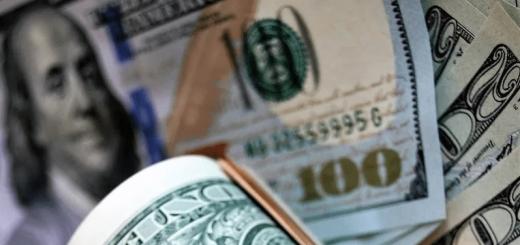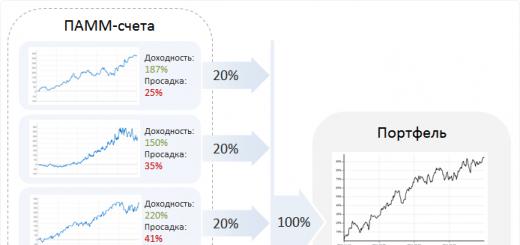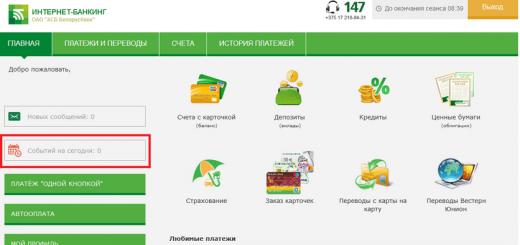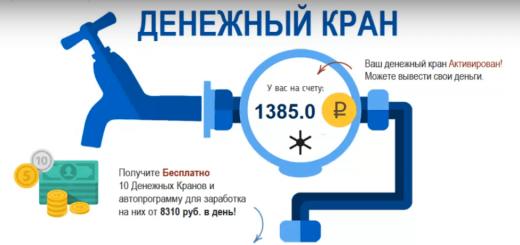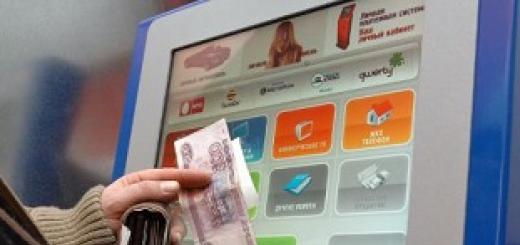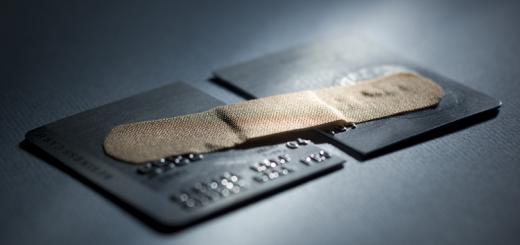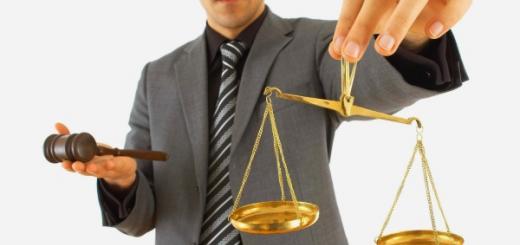In modern Russian accounting and reporting, the role of International Standards is increasing financial reporting(IFRS). Strategy for convergence of Russian standards accounting(RAS) with IFRS is carried out by the Government Russian Federation already for many years.
Despite the strategy of convergence with IFRS, the principles set out in Russian accounting standards cannot be called fully compliant with IFRS, and at present there are still a significant number of differences in definitions and approaches to the assessment and reflection of items in financial (accounting) statements.
Here we compare the main requirements for the accounting and reporting of transactions with investment property in accordance with IFRS and RAS and possible adjustments that may be required when transforming the reporting of a company's investment property.
Definition of investment property
investment property- This real estate held by an entity (either as an owner or a lessee under a finance lease) for the purpose of leasing or increasing its value, and not for the purpose of use in the production process and for administrative purposes, or for sale.
IAS 40 Investment Property is devoted to accounting for investment property. Investment property is property that must meet all of the following four criteria:
1) types of real estate: land or building; or part of a building; or both; 2) the real estate is in the possession of: the owner; or a lessee under a financial lease agreement (leasing agreement); 3) purposes of owning real estate: receiving rental payments; or capital appreciation; or both; 4) the purposes of possession are not: use in the production or supply of goods, provision of services, for administrative purposes; sale in the ordinary course of business.
IN IAS 40 examples of investment properties are presented:
- land held for capital appreciation, but not for sale in the short term;
- land, the further use of which is currently not determined;
- a building owned by an enterprise (owner or lessee under a leasing agreement) and provided for operating lease (but not for financial lease) in whole or in part;
- a building not currently occupied, but intended to be rented in whole or in part, and not for sale;
- real estate under construction or development (but not on behalf of third parties), for the purpose of further use as investment property, and not for sale;
- Property held by a lessee under an operating lease may only be classified and accounted for as investment property if such property otherwise meets the definition of investment property.
There is no analogue of IFRS 40 "Investment property" in Russian legislation yet. The closest object of accounting in Russian practice are profitable investment in material values
accounted for on account 03 "Profitable investments in material assets".
In accordance with the Chart of Accounts profitable investments in material assets are the investments of the organization in part of the property, buildings, premises, equipment and other valuables that have a material form, provided by the organization for a fee for temporary use (temporary possession and use) in order to generate income. Thus, there is a discrepancy between the concepts of investment property (IFRS 40) and profitable investments in tangible assets (see Fig. 1).
Rice. 1 The ratio of investment property (IFRS 40) and profitable investments in tangible assets (account 03 Chart of accounts)
Region A- these are investment properties in accordance with IAS 40, but not income-generating investments in tangible assets in accordance with Russian legislation: real estate (land or a building, or part of a building, or both) that is at the disposal (of the owner or lessee under finance lease agreement) for the purpose of capital gains. Such objects are accounted for under Russian law on account 01 "Fixed assets".
Region B- these are objects that are both investment property in accordance with IFRS 40 and profitable investments in tangible assets according to Russian accounting: land and buildings held by the organization in order to receive rental payments, i.e. provided for operating lease. These real estate objects under the Russian legislation are reflected on account 03 "Profitable investments in material values".
Region B- these are objects that are profitable investments in material values, but are not investment property in the understanding of IFRS: equipment and other items of property, plant and equipment, except for buildings and land, as well as other values that have a material form provided by the organization for temporary use in order to generate income. The considered material assets in accordance with the Chart of Accounts are accounted for on account 03 “Profitable investments in material assets”.
Accounting for profitable investments in material assets in Russian accounting is carried out in accordance with PBU 6/01 "Accounting for fixed assets", and generally complies with the cost accounting model provided for by IFRS 40. At the same time, if a Russian organization has exercised the right to revaluate income investments in tangible assets, then this option will not comply with the fair value accounting model proposed by IFRS 40. It is important to note that, in contrast to of the provisions of international standards, land plots in accordance with Russian legislation are not subject to revaluation (clause 43 of the Methodological Guidelines for Accounting of Fixed Assets).
IFRS distinguishes between property acquired for investing activities and investment property. Common situation: in a traffic report Money expenses appear as part of investing activities, and in the balance sheet they form the cost of an ordinary fixed asset.
In addition, Russian accounting uses such a term as " long term investment"in the field of accounting for construction and investment activities. In accordance with the Regulations on accounting for long-term investments, approved by the Letter of the Ministry of Finance of Russia of December 30, 1993 N 160 (hereinafter - Regulation N 160), long-term investments are understood as the costs of creating, increasing the size, as well as acquisition of non-current non-current assets (more than one year) not held for sale, except for long-term financial investments to state securities, securities and authorized capitals other enterprises.
In accordance with Regulation N 160, long-term investments are associated with the implementation of capital construction in the form of new construction, as well as reconstruction, expansion and technical re-equipment of existing enterprises and non-production facilities; acquisition of buildings, structures, equipment, Vehicle and other separate objects (or parts thereof) of fixed assets; acquisition of land plots and nature management facilities; acquisition and creation of intangible assets.
As you can see, only objects that are in the process of being manufactured or acquired fall under the definition of long-term investments in accordance with Regulation N 160.
As follows from the presented definitions, the concept of investment property under IFRS does not fully coincide with the definitions of long-term investments and profitable investments in tangible assets under RAS.
The main differences between the concepts of "investment property" under IAS 40 and "long-term investments" under Regulation N 160 can be formulated as follows:
- long-term investments are only objects that are in the process of being manufactured or acquired, while objects ready for operation also fall under the concept of investment property;
- investment property can only be real estate, while long-term investment is a broader concept, and this includes any fixed assets and intangible assets;
- investment property, unlike long-term investments, cannot be intended for use in the production or supply of goods, provision of services, or for administrative purposes.
In turn, there are significant differences between the definitions of "investment property" under IFRS and "profitable investments in material assets" under RAS:
- profitable investments in material assets can be any fixed assets, while only real estate objects are investment property;
- PBU 6/01, in contrast to IAS 40, does not specify such a purpose of owning property as an increase in the value of capital for profitable investments in material assets.
- IAS 40 requires the use of professional judgment to determine whether a property is an investment property. The enterprise develops criteria for determining investment property in accordance with the standard, which is especially important when the classification of an object is difficult. In RAS, in general, all definitions provide clearer criteria that do not involve the use of professional judgment.
Investment Property Accounting
Investment property is recognized as an asset only when it is probable that it will provide future economic benefits and the value of the investment property can be measured reliably.
Under IAS 40, investment property must initially be measured at cost, including transaction costs. The actual cost of acquiring investment property includes the purchase price and all direct costs. Direct costs include, for example, professional legal fees, real estate transfer taxes and other transaction costs.
In general, the measurement of the initial cost of investment property under IFRS does not differ from the principles of measurement under RAS, however, there are some differences, the most significant of which are the following:
- when payment for investment property is deferred, the actual cost is determined as the present value, the difference between this amount and the total amount of payment is recognized as interest expense over the period of deferral;
- the cost of a share of real estate held by an enterprise under a lease and classified as investment property is determined in the same way as for a finance lease, i.e. the asset should be recognized at the lower of the fair value of the property and the present value of the minimum lease payments, and the equivalent amount should be recognized as a liability;
- when acquiring investment property by exchange, with some exceptions provided in IAS 40, its value is measured as fair value;
- as already mentioned, the initial cost under IFRS of investment objects received on lease does not always coincide with the initial cost under RAS due to differences in its definitions;
- when first applying IFRS in accordance with IFRS 1 "First-time Adoption of International Financial Reporting Standards", an entity has the right to measure an investment property at fair value if it has chosen the cost model.
Subsequent valuation of investment property is carried out in one of the following ways:
Fair value accounting- after the initial recognition of objects in the amount of costs for their acquisition, all objects are measured at fair value, which reflects the state of market prices at the reporting date. Gains (losses) from changes in fair value are recognized in the income statement in the period in which they occur.
Acquisition Cost Accounting- investment property is valued at actual cost acquisitions less accumulated depreciation and accumulated impairment losses.
In the course of doing business under IFRS, investment property may need to be reclassified. Transfer of an object to investment property or withdrawal from its composition is carried out only in the event of a change in the method of its operation, confirmed by the following events:
1) start using the object in production activities- transfer of an object from investment property to fixed assets;
2) the beginning of preparation for sale - the transfer of an object from investment property to reserves;
3) the end of use in production activities - the transfer of an object from fixed assets to investment property;
4) commencement of operating lease - transfer of an object from reserves to investment property;
5) completion of construction or reconstruction - the transfer of an object from property under construction or reconstruction (fixed assets) to investment property.
When an item carried at fair value is transferred from investment property to other types of assets, the item begins to be accounted for in its new capacity at fair value.
In RBU there is no practice of transferring fixed assets or objects of long-term investments in tangible assets into assets held for sale (inventories) if the enterprise decides to sell these objects. These objects will continue to be listed on the Russian accounting accounts corresponding to their original purpose, such as, for example, accounts 01 or 03. Therefore, for the purposes of reporting under IFRS, it will be necessary to use not only accounting data, but also to know the company's plans to sell those or other real estate objects.
Transformational Adjustments
Transformation entries upon transition to IFRS:
Upon transition to IFRS Russian organizations special attention should be paid to the presence of objects that meet the criteria for recognition of investments in real estate in accordance with IAS 40 Investments in Real Estate. Application fair value models one of the few tools to increase retained earnings (net profit of the reporting period) of an organization compared to similar indicators under RAP, since prices for real estate (land and buildings) tend to rise.
In the case of the transformation of Russian financial statements into financial statements prepared in accordance with IFRS, the following are possible: transformation records related to the recognition of investment property:
Reclassification entries:
- transfer of property, plant and equipment to investment property (IFRS 40),
- transfer of income-generating investments in tangible assets to fixed assets (IFRS 16) or investment property (IFRS 40);
records related to the adjustment of methods of accounting and valuation of investment property to the fair value model or the cost model, including:
"withdrawal" of the results of the Russian revaluation, if the objects of investment property were subject to revaluation in accordance with PBU 6/01;
exclusion of accrued depreciation, inclusion of changes in fair value in the net profit (loss) of the reporting period (if the fair value model is applied);
records specifying useful lives, depreciation methods, residual value estimates reflecting impairment losses under IAS 36 (if accounting policy accounting model is provided for at historical cost).
Possible adjustments that may be required in the transformation of reporting in relation to the company's investment property:
- Reclassification of investment property in accordance with IFRS from income-generating investments in tangible assets / fixed assets in accordance with RAS
- Reclassification of the cost of investment property under IFRS from inventory under RAS
- IFRS recognition of investment property held under a finance lease that meets the definition of investment property
- Reclassification of a property under construction to investment property
- Recognition of investment property held under an operating lease that meets the definition of investment property
- Transfer of investment property to property, plant and equipment
- Recalculation of the cost of investment property upon acquisition
- Bringing the cost of the investment property to its fair value upon receipt of the investment property by exchange
- Formation of the initial cost of investment property received under an operating or finance lease
- Recalculation of the value of investment property due to its overhaul
- Accrual of impairment loss on investment property when using the cost method
- Reversal of accrued depreciation on investment property measured at fair value
- Adjustment of accrued depreciation on investment property
- Adjustment in the value of investment property obtained through the transfer of property, plant and equipment to investment property
- Revaluation of investment property transferred from income-generating investments in tangible assets or property, plant and equipment (the result of the revaluation is attributed to Equity)
- Transfer of inventories to investment property
- Revaluation of investment property at fair value (result of revaluation is charged to profit/loss)
- Adjustment in the value of investment property received through transfer from non-current assets held for sale
- Reversal of transactions for the sale of investment property due to the fact that the risks and rewards of the asset being sold have not been transferred to the buyer
- Write-off of investment property transferred under a finance lease
- Write-off of investment property depreciated under IFRS (or vice versa).
Problems of transformation
Errors in reports prepared according to international standards are divided into three groups. Firstly, these are the shortcomings that were made in the preparation of reports on Russian standards. Secondly, during its transformation. And, finally, thirdly, errors that occur during the preparation of financial statements in accordance with IFRS. Errors that belong to the first and second groups can only appear if the company prepares IFRS statements by transformation. In the course of this process, statements prepared in accordance with Russian standards are adjusted in accordance with the requirements of IFRS. It is clear that if there are errors in the first one, most of them will “migrate” to reports compiled according to international standards. For the same companies that keep records in parallel according to IFRS and RAS, there will be no errors of this kind.
Errors in reporting prepared in accordance with IFRS, which are classified in the first group, can be corrected in two ways. The first is to change the initial data. We are talking about reporting indicators, which are compiled according to Russian standards. The second is to make additional adjustments that relate to the mistakes made. Choosing one or another method, firms primarily proceed from the number of detected shortcomings.
If there are, say, more than a hundred errors, then it is easier to generate new reporting in accordance with Russian standards. And if there are only two or three of them, of course, it is better to make additional adjustments. If you find errors in Russian accounting before submitting a report to tax office, it is better to use the first method. Let's explain why. During the audit of IFRS reporting, which was prepared by the transformation method, auditors will compare the data of the transformation tables with the balance sheet and income statement submitted to the tax office. If they find discrepancies, then you will have to explain their reason. If the errors were corrected by adjustments in the transformation process, then no one will require additional explanations.
During the transformation of reporting, the probability of errors is very high. After all, this process includes several stages. Often it is carried out without special software, only with Excel help. The most complex of them is the reclassification of income, expenses, assets and liabilities. The fact is that there is a big risk that any assets or costs will not be reclassified. Or, even worse, they will be excluded from the group in which they were listed under RAS, and not included in the group where they should be in accordance with IFRS. Let's take an example.
Let's say a company has a building on its balance sheet that it rents out as an operating lease. According to the requirements of RAS, it must be considered as a fixed asset. And according to IFRS, it is an investment property. This means that when compiling IFRS statements, this property must be transferred from the Fixed Assets group to the Investment Property group each time. If a company does this without special computer programs, it is quite possible that errors will appear.
For example, accountants:
a) they forgot to transfer an object from the Fixed Assets group to the Investment Property group;
b) they removed it from the Fixed Assets group, but did not place it in the Investment Property group;
c) incorrectly reflected the value of the object in the Investment Property group, etc.
In order to reduce the number of errors both during the reclassification and at the entire transformation stage, it is necessary to minimize the influence of " human factor". To do this, it is enough to develop high-quality transformation tables and control the correctness of the information entered into them. It is also necessary to clearly spell out all the necessary procedures for the transformation process for each type of assets, liabilities, income and expenses, and possibly for individual operations. For each company, these procedures will be different. They depend on the type of activity, organizational structure, business procedures used, the amount of information processed and many other criteria.
It is even better if the company uses special computer programs for the transformation of reporting. For example, transformation procedures can be set up in the same program in which the company keeps records according to Russian standards.
However, even despite all the measures taken to prevent errors, they cannot be completely avoided. Found deficiencies need to be corrected.
Conclusion
In Russian accounting and reporting, the role of IFRS is increasing.
When developing accounting policy for 2012, it should be remembered that the difference in accounting models under IFRS and Russian rules will entail additional adjustments during the transformation, in particular in relation to the book value of the object, accumulated depreciation. In addition, adjustments may be related to the refinement of useful lives and the determination of impairment losses.
- This article is so unique, that we couldn't find any services related to it!
Recognition, evaluation and disclosure of information about investment property governed by IAS 40 Investment Property. Investment property is property, such as land and buildings (may be part of a building), or both, held by a company to earn rental income and/or capital appreciation.
If part of the property is used to receive rent, and the other for the production of goods (works, services), then the company must account for them separately. However, if only a minor part is used for production, then the standard allows the item to be classified as investment property. Property leased by a parent or subsidiary company is not investment property, as for a group of companies it is owner occupied property.
Investment property is recognized when it is probable that future economic benefits will flow and its cost can be measured reliably.
Initially, investment property is valued at actual purchase costs, which consists of the cost of the property and direct purchase costs. Subsequently, an entity must determine in its accounting policy whether it chooses to account for investment property at fair value or at cost. In this case, the selected accounting method should be applied to all investment properties.
The fair value of an item is the amount for which the item could be exchanged in a transaction between knowledgeable, willing and independent parties. Changes in fair value are recognized in profit or loss in the period in which they occur.
The cost model recognizes investment property at cost less accumulated depreciation and accumulated impairment losses (if any), which is consistent with property, plant and equipment.
Termination of lease agreements and transfer of property to owner-occupied property;
The beginning of reconstruction for the purpose of sale, when transferred to stocks;
Commencement of an operating lease under a contract.
Investment property should be derecognised when no economic benefits are expected from the property. The disposal of an investment property occurs when it is sold or transferred to a financial lease.
Mandatory disclosures are: investment property accounting model, criteria for classifying investment property, the degree of valuation performed by an independent appraiser, the amount of rental income from investment property, direct operating expenses and cumulative change in fair value.
In addition to IAS 16, there are several other standards for accounting for long-term assets and IAS 40 Investment Property is one of them. Consider the basic rules for classifying and accounting for investment property.
Many accountants mistakenly believe that there is only one standard that applies to long-term tangible assets: IAS 16 Property, Plant and Equipment.
While it is true that you need to apply IAS 16 to account for most of your long-term tangible assets, it is not the only standard for accounting for this category of assets.
Consider the main provisions of the standard IAS 40 Investment Property defining what investment property is, its initial and subsequent accounting, fair value model and other issues.
What is IAS 40?
Accounting for IAS 40 Investment Property is identical to accounting for IAS 16 Property, Plant and Equipment except that:
- revaluation results under IAS 40, both positive and negative, are included in profit and loss (and not in the revaluation reserve), and
- there is no depreciation if the revaluation is carried out every year.
What is the purpose of IAS 40?
IAS 40 Investment Property prescribes the accounting and disclosure of information in relation to investment property.
But what is investment property?
Investment property is land, building (or part of it), or both designed for the following specific purposes:
- Receipt rent;
- Cost increase capital; or
- Both. (see paragraph IAS 40.5)
Here it is of great importance purpose of holding the asset . If you hold a building or land plot for any of the following purposes, then this asset cannot be classified as investment property:
- Production or sale of goods or services,
- administrative purposes or
- Sale within operating activities.
If you use your building or land for the first two purposes, you should apply IAS 16; and IAS 2 Reserves is appropriate when you use a building or land for sale in the course of operations.
Examples of investment properties.
What exactly can be attributed to investment property?
- Land held for resale in the long term at a higher price (as a result of appreciation) or for future uncertain use (i.e. you do not yet know what you will use it for).
However, if you are buying land and intend to build a production facility on it for your main business some time later, then this land is NOT an investment property. - A building owned by an entity that is leased out under one or more operating leases. This includes a building that is currently vacant but you plan to rent it out.
- Any property that you actually build for future use as an investment property.
Be careful here because if you are building a building for any third party, it is NOT investment property and you must apply IAS 11 Construction Contracts or IFRS 15 Revenue from Contracts with buyers".
When to recognize investment property in accounting?
The recognition rules for investment property are basically the same as in IAS 16 for property, plant and equipment, i.e. you recognize investment property as an asset only if two conditions are met:
- It is probable that the future economic benefits associated with this asset will be transferred to the company; and
- The value of an asset can be estimated reliably.
How is the initial appraisal of investment property carried out?
Investment property is initially valued at cost, including transaction costs (acquisition costs).
The cost of investment property includes:
- acquisition cost and
- Any costs directly related to the acquisition, such as legal fees or consulting fees, property taxes, etc.
In cost price cannot be included:
- Any startup costs.
However, if these start-up costs are directly related to the operation of the investment property, you may want to include them. But DO NOT include total startup costs. - Operating losses incurred by the company before the property reached its intended level of use, and
- Excess consumption material, labor or other resources that arise during the construction of a property.
If payment for an investment property is delayed, you will need to discount the amount of that payment to present (current) value to establish a current cash value equivalent.
It should also be mentioned that you can actually classify an asset under a finance lease as an investment property, in which case the cost is calculated in accordance with IFRS 16 Leases.
How is the subsequent valuation of investment property carried out?
After initial recognition, you have 2 options for valuing your investment property (IAS paragraph 40.30 et seq.).
Once you have made your choice, you should stick to it and value all your investment properties using the same model (there are actually exceptions to this rule).
Option 1: Measurement using the fair value model.
In accordance with fair value model investment property is measured at fair value at the reporting date. (see IAS paragraph 40.33).
Fair value measurement is defined in IFRS 13 Fair Value Measurement .
The fair value gain or loss is recognized in profit or loss.
Sometimes fair value cannot be measured reliably after initial recognition. It's possible in extremely rare cases , in which case IAS 40 prescribes (see paragraph 53):
- Measure investment property at cost if it is not yet completed and is under construction; or
- Valuate the investment property using the initial cost model, if completed.
Option 2: Estimate by upfront cost model.
The second option for the subsequent valuation of investment property is initial cost model.
This valuation model IAS 40 does not describe it in detail, but refers to IAS 16 Fixed Assets. This means that you need to apply the same methodology as in IAS 16.
How to switch to another investment property appraisal model?
Can you actually move from a cost model to a fair value model or vice versa from a fair value model to a cost model?
The answer is "YES", but only if the change results in more reliable information about the company's financial statements. financial position and results.
What does this mean in practice?
Moving from a cost model to a fair value model is likely to meet this condition and therefore you may do so if you are confident that you can measure fair value regularly and that the fair value model is a better fit.
However, the opposite change (from a fair value model to an initial cost model) is unlikely to result in a more reliable presentation of assets. Therefore, you should not do this, but if you do, it is rare and for good reasons.
How to transfer assets from and to investment property?
When we talk about transfers ( transfers from category to category) associated with investment property, we mean reclassification. For example, you reclassify a building previously accounted for as property, plant and equipment under IAS 16 to investment property under IAS 40.
A transfer is possible, but only if there is a change in the use of the asset or the purpose of holding the asset, for example (see paragraph IAS 40.57):
- You start leasing property that was previously used as an office building (conversion of previously owner-occupied property to investment property under IAS 16).
- You stop renting out the building and start using it yourself.
- You owned the land for no particular purpose and recently decided to build a residential building on it to sell apartments (transfer from investment property to stocks).
How is the transfer of real estate from category to category reflected in accounting?
This depends on the type of transfer and the chosen accounting policy for the investment property.
If you choose to account for your investment property under the upfront cost model, then there is no problem with transfers, you simply continue to record as you did before.
However, if you chose the fair value model, things are a bit more complicated:
- When you transfer an asset to investment property, then the assessed value of the asset will be its fair value at the date of the transfer. The difference between the asset's carrying amount and fair value is treated and accounted for in the same way as a revaluation under IAS 16.
- When you transfer an asset from an investment property, the value of the asset will also be its fair value at the date of the transfer.
How to derecognise investment property?
The rules for derecognition (i.e. when you can liquidate investment property and derecognise it) in IAS 40 are similar to those in IAS 16.
Disclosure of information on investment property.
IAS 40 Investment Property prescribes a variety of disclosures that must be presented in financial statements, including:
- description of the chosen model,
- how the fair value was measured,
- investment property classification criteria,
- transfers of investment property from category to category during the reporting period.
For more information on disclosures, see paragraphs
IAS 40 "Investment Property" is devoted to the issues of accounting for investments in fixed assets.
investment property is real property owned by an entity (either as an owner or a lessee under a finance lease) for the purpose of leasing or increasing its value, and not for the purpose of use in the production process and for administrative purposes, as well as for sale.
In Russian practice, fixed assets that are intended solely to be provided by an organization for a fee for temporary possession and use are accounted for as profitable investments in tangible assets.
Investment property is recognized as an asset only when it is probable that it will provide future economic benefits and the value of the investment property can be measured reliably.
The cost of an investment property includes the initial acquisition costs and all direct acquisition costs. The value of the constructed investment property is determined at the time the construction or renovation is completed. Until construction is completed, IFRS 16 is applied to account for the facility.
Subsequent valuation of investment property is carried out in one of the following ways:
- Fair value accounting - after the initial recognition of objects in the amount of costs for their acquisition, all objects are measured at fair value, which reflects the state of market prices at the reporting date. Gains (losses) from changes in fair value are recognized in the income statement in the period in which they occur.
- Acquisition cost accounting - investment property is valued at cost less accumulated depreciation and accumulated impairment losses.
- the beginning of the use of the object in production activities - the transfer of the object from investment property to the composition of fixed assets;
- start of preparation for sale - transfer of the object from investment property to reserves;
- end of use in production activities - transfer of an object from property, plant and equipment to investment property;
- start of operating lease - transfer of an object from reserves to investment property;
- completion of construction or reconstruction - the transfer of an object from property under construction or reconstruction (fixed assets) to investment property.
investment property is an investment in property that is not intended to be used in the entity's business or sold in the ordinary course of business. It includes land plots, buildings or parts of buildings that are at the disposal of the owner or tenant under a financial lease (leasing) agreement, used to receive rental payments, income from property appreciation, but not involved in the process of production and sale of goods, works, services ; not used for administrative purposes; not held for sale in the ordinary course of the entity's operations.
Reclassification of objects of investment value, that is, their inclusion in this category or exclusion from it, is made according to the actual purpose of this or that object of the organization's property.
Transfer of an object from investment property to a property for sale produced with the beginning of its reconstruction to prepare for sale. However, if the decision is made to sell the investment property without refurbishment, it continues to be classified as investment property until it is disposed of as a result of the sale.
The object is included in the investment property:
after completion of construction or reconstruction;
after the end of its use in production, management, commercial operations;
after being transferred to an operating lease to a third party.
An object is excluded from investment property:
with the beginning of its use in production, management or commercial operations;
with the beginning of reconstruction as a preparatory pre-sale operation.
Recognition and Initial Evaluation. Investment property is recognized as an entity's assets as a separate item of accounting when it is reasonably probable that rental payments or capital appreciation will be received in accordance with the requirements for investment property, and the value of the latter can be measured reliably.
The initial appraisal of investment property is made at the cost of its acquisition or construction, not excluding construction by economic means.
The cost of acquiring investment value includes the price of the object and direct transaction costs (legal, consulting services, registration, etc.). Interest for deferred payment is not included in the cost price, it is included in recurring expenses during the term of the loan. Objects built by contractors are valued according to the price of the contract.
The cost of a home-built investment property is determined by the sum of all costs as of the completion date of the facility. Costs of assets in progress are accounted for like any other capital construction costs. Separate accounting for investment property begins from the date of completion of construction and acceptance of the object into operation.
The cost of excess consumption of materials and other resources consumed during the construction or reconstruction of facilities is not included in their initial cost. Costs associated with the commissioning of an investment property are not included in its cost, with the exception of those costs that are necessary to bring the property to working condition. But the initial losses associated with temporary difficulties in attracting tenants, other similar losses are written off as expenses of the reporting periods in which they arose.
Subsequent incremental expenses are charged to the increase in the carrying amount of the investment property if they increase the profitability of the investment property. In all cases where a loss of profitability is reflected in the original price of an item, its recovery through modernization or other subsequent costs should be reflected in an increase in the carrying amount of the item. Other subsequent expenses are not capitalized. They should be written off as expenses of the period in which they arose.
Models for the subsequent valuation of investment property objects. IAS-40 allows to apply for the accounting of objects of investment property: fair value, and reflect its changes in profit and loss; initial acquisition cost, at which investment property is carried in the balance sheet at its residual value, that is, less accumulated depreciation and impairment losses. The use of acquisition cost accounting does not preclude the need to disclose the fair value of investment property in the notes to the financial statements.
This model differs from revaluation accounting, which is commonly used for accounting for tangible assets, in that the excess of the revalued amount over the original carrying amount is recognized in the capital accounts as an increase in the value of property. The application of the fair value model assumes that all changes in value are recognized only in profit and loss.
The difficulties of determining the fair value for many objects of investment value are also obvious. The fair value of investment property should reflect market conditions and actual market and other conditions at the reporting date and not at any other date. Changing market conditions lead to changes and inaccuracies in fair value measurements. For many investment properties, active market prices cannot be relied upon, and tariff factors of rent also come into play.
Each organization undertakes to apply the selected valuation procedure for all investment properties. Often, for objective reasons, it is impossible to provide a fair value assessment of all available items.
Reclassification is measured using one of two models: historical cost or fair value. When measured at cost, any reclassification of investment property does not result in any change in its carrying amount and therefore does not require any accounting for variances. On the contrary, when measuring investment property at fair value, deviations arise that require accounting and reflection in the financial statements.
Investment property is reclassified to property, plant and equipment, inventories or other owner-occupied property categories at fair value, which is recognized as the carrying amount of the items at the time they change their use within the entity.
Investment property objects are disposed of by their sale or financial lease under a leasing agreement. The sale price of an object is determined by its fair value at the date of disposal. When a commercial loan or installment payment is granted, the difference between the actual consideration and the fair value (price) is accounted for separately as received interest income. Arising profits (losses) are reflected in the profit and loss account.
Upon the final decommissioning (writing-off) of an object of investment value, the possible amount of losses is reflected as a loss in the reporting period in which the object is written off.
